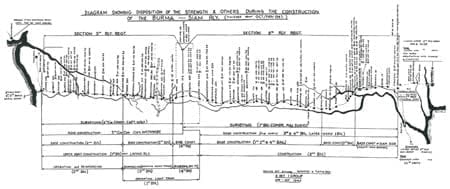A railway route between Thailand and Burma had been surveyed at the beginning of the 20th century, by the British Government; however the proposed course of the line – through hilly jungle terrain divided by many rivers – was considered too difficult to complete.
In 1942, Japanese forces, supplies and equipment transported from East and North Asia to Burma by sea, through the Strait of Malacca, were vulnerable to attack by Allied submarines, and an alternative means of transport was needed.
The Burma Railway was also known as the “Death Railway” as 16,000 allied troops and 100,000 Asian labourers died during its construction. The final route was between Bangkok in Thailand and Rangoon, Myanmar (Burma). Work began at both ends of the rail line in June 1942.
The living and working conditions on the railway were horrific. The estimated total number of civilian labourers and POWs who died during construction is approximately 160,000. About 25% of the POW workers died because of overwork, malnutrition, and diseases like cholera, malaria, and dysentery. The death rate of the Asian civilian workers was even higher; the number who died is unknown, as the Japanese did not count them.
Australia’s involvement in the construction of the Burma Railway
Following the fall of Singapore in 1942, 22,000 Australians were taken prisoner of war by the Japanese and held at Changi prison. Some were sent to Japan, Taiwan and Borneo but the majority were sent to work on the Burma railway. The POWs were transported by rail in appalling conditions; a five-day journey with up to 40 men in a carriage. With only basic tools, work was slow and men had to walk many miles to work sites and complete gruelling 12-hour shifts. With the incredibly long hours, malnutrition and deteriorating health, beriberi, tropical ulcers, cholera and dysentery the death rate was extreme. Beatings, beheadings and even crucifixion showed the brutality of the Japanese soldier.
The Army prisoners were largely from the 8th Division captured at the fall of Singapore with POW’s from the RAN and RAAF. Australian were also captured on Java, Timor, Ambon and New Britain. Throughout the war, Changi in Singapore was the main camp from which working parties were sent to other destinations and through which prisoners of war captured in other areas were staged.
Australian prisoners of war were sent from Singapore to:
- Burma : A Force
- Thailand : D, F, H, Forces and K and L Forces (medical forces)
- Japan : C, G and J Forces; Senior Officers Party
- Borneo : B and E Forces
- Manchuria, Indochina, Formosa and Korea.
The Railway was completed on the 16th October 1943 with over 2,600 Australians dying while working on the railway.
For further information, please refer to the Australian War Memorial website:

